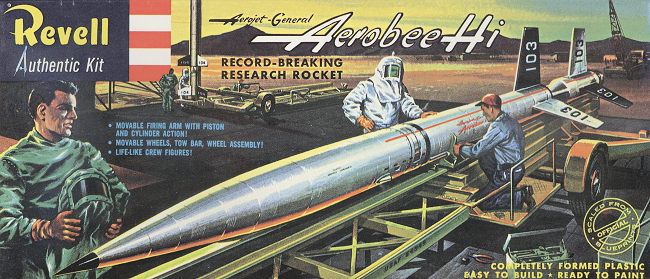
Revell 1/40 Aerobee-Hi
| KIT #: | H-1814 |
| PRICE: | $10.50 when new in 1996 |
| DECALS: | one option |
| REVIEWER: | Scott Van Aken |
| NOTES: | Reissue of 1958 kit |

| HISTORY |
The Aerobee rocket was one of the United States of America's most produced and productive sounding rockets. Developed by the Aerojet Corporation, the Aerobee was designed to combine the altitude and launching capability of the V-2 with the cost effectiveness and mass production of the WAC Corporal. More than 1000 Aerojets were launched between 1947 and 1985, returning vast amounts of astronomical, physical, aeronomical, and biomedical data.
The first major derivative version, the Aerobee-Hi (first launched in 1955) featured an increase in length, fuel capacity and improved engineering design. There were two versions of the Aerobee-Hi. The Air Force Aerobee Hi, (MX-1960, XRM-84) and the slightly longer Navy Aerobee-Hi (RV-N-13, PWN-2A). Engine development continued with the AJ11-6, AJ11-18, AJ11-20, AJ11-21, and AGVL0113C/F/H/I of the Aerobee-Hi. The Aerobe-Hi was boosted by the 2.5 KS-18000 booster. The Navy Aerobee-Hi was considerably different from the Air Force Aerobee-Hi, using the fuel pressure regulator from the Nike Ajax, a delayed start function and a pressure sealed tail cone to allow better measurement of the external upper atmosphere.
| THE KIT |
Back in the 1950s and early 1960s, Revell released a number of kits of various rockets and missiles. One of them was the Aerobee. Built to 1/40 scale to match other military vehicles, and because that just happened to fit a standard box, the kit itself was only reissued one time (1996) since its initial 1958 tooling. The tooling has since been purchased by Atlantis and I don't doubt they will reissue it in the future.
The kit comes in two bags. One is white plastic and contains the parts that make up the rocket. The other is the trailer on which the missile sits. This is in medium grey plastic and while generally flash free, there is some flash attached to the main sprues. The main trailer frame is a single piece to which the wheels and the launching framework is attached. This launch frame is designed to be movable in elevation if one properly builds the main piston. Experience with this sort of things shows that careful building and a bit of lubricant (petroleum jelly works well) ensures proper operation. The kit also includes three figures with bases, two of them wearing 'refueling suits'.
 Instructions
are duplicates of the original and provide exploded views, as was the norm of
the time, along with generic color information and part names. This is all on
one side of the instructions with the other side providing an advert of other
Revell kits. The decal sheet is a bit thick and glossy, but should work well.
Instructions
are duplicates of the original and provide exploded views, as was the norm of
the time, along with generic color information and part names. This is all on
one side of the instructions with the other side providing an advert of other
Revell kits. The decal sheet is a bit thick and glossy, but should work well.
| CONCLUSIONS |
If the modern modeler treats these older kits like short run kits, then a very nice replica can be built. I can recall as a youngster, being frustrated that my lack of cleaning up parts resulted in poor fit. It is nice that these older kits have been reissued and other than its nostalgia factor, this happens to be the only kit of this subject of which I am aware.
| REFERENCES |
https://en.wikipedia.org/wiki/Aerobee
September 2021 Copyright ModelingMadness.com.
All rights reserved. No reproduction in part or in whole without express
permission. If you would like your product reviewed fairly and
fairly quickly, please
contact
the editor
or see other details in the
Note to
Contributors.